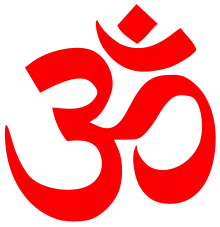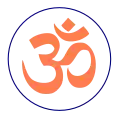| Part of a series on |
| Hindu scriptures and texts |
|---|
 |
| Related Hindu texts |
Samanya Upanishads or Samanya Vedanta Upanishads are minor Upanishads of Hinduism that are of a generic nature. They were composed later and are classified separate from the thirteen major Principal Upanishads considered to be more ancient and connected to the Vedic tradition.[1]
The Samanya Upanishad as group contrast with other minor Upanishads grouped as the Yoga Upanishads which are related to Yoga, the Sannyasa Upanishads which are related to Hindu renunciation and monastic practice, the Shaiva Upanishads which are related to Shaivism, the Vaishnava Upanishads which are related to Vaishnavism, and the Shakta Upanishads which are related to Shaktism.[1][2]
The Samanya Vedanta Upanishads are variously classified, ranging from a list of 21 to 24.[3][4] The variation in count is based on whether some of the older Principal Upanishads are included as Samanya. Some include three ancient Upanishads as Samanya Upanishads bringing the list to 24: 14. Shvetashvatara Upanishad; 24. Maitrayaniya Upanishad; and 25. Kaushitaki Upanishad. If these three are included as Samanya Upanishads, the list of Principal Upanishads shrinks to ten. Many scholars, however, consider the Principal Upanishads to be thirteen.[5][6][7]
Nomenclature
The term samanya literally means "generic, universal".[8]
Date
The Principal Upanishads are dated to be between eighth and first century BCE, the estimates for the minor Upanishads vary. According to Mahony, the minor Upanishads are approximately dated to be from about 100 BC to 1100 AD.[9]
List of 21 Samanya Upanishads
List of 24 Samanya Upanishads
The list of Samanya Upanishad varies by the scholar. For example, Brahmayogin's list of 24 included Annapurna Upanishad, Maitri Upanishad and Kaushitaki Upanishad as Samanya Upanishads.[10]
See also
References
- 1 2 William K. Mahony (1998). The Artful Universe: An Introduction to the Vedic Religious Imagination. State University of New York Press. p. 271. ISBN 978-0-7914-3579-3.
- ↑ Moriz Winternitz; V. Srinivasa Sarma (1996). A History of Indian Literature. Motilal Banarsidass. pp. 217–224 with footnotes. ISBN 978-81-208-0264-3.
- ↑ Rabindranath Tagore (1941). The Visva-bharati Quarterly. p. 97.
- ↑ Nair 2008.
- ↑ Hume, Robert Ernest (1921), The Thirteen Principal Upanishads, Oxford University Press
- ↑ Edward Fitzpatrick Crangle (1994). The Origin and Development of Early Indian Contemplative Practices. Otto Harrassowitz Verlag. pp. 8, 12. ISBN 978-3-447-03479-1.
- ↑ John G. Arapura (2012). Gnosis and the Question of Thought in Vedānta: Dialogue with the Foundations. Springer. p. 57. ISBN 978-94-009-4339-1.; Quote: "These are the Isha, Kena, Katha, Prasna, Mundaka, Mandukya, Aitareya, Taittiriya, Brihadaranyaka, Chandogya and Svetasvatara. To this list is usually added the Kaushitaki and Maitrayaniya or Maitri) to make the thirteen principal Upanishads, a canon which has found favor with most scholars of the present day."
- ↑ Roshen Dalal (2010). Hinduism: An Alphabetical Guide. Penguin Books. p. 314. ISBN 978-0-14-341421-6.
- ↑ Mahony 1998, p. 290.
- ↑ AL Sastri (1918). Report. Adyar Library.
Bibliography
- Aiyar, K. Narayanasvami (1914). Thirty Minor Upanishads. Archive Organization. Retrieved 15 June 2016.
- Deussen, Paul (1997). Sixty Upanishads of the Veda. Motilal Banarsidass. ISBN 978-81-208-1467-7.
- Mahony, William K. (1998). The Artful Universe: An Introduction to the Vedic Religious Imagination. SUNY Press. ISBN 978-0-7914-3579-3.
- Nair, Shantha N. (2008). Echoes of Ancient Indian Wisdom. Pustak Mahal. ISBN 978-81-223-1020-7.
